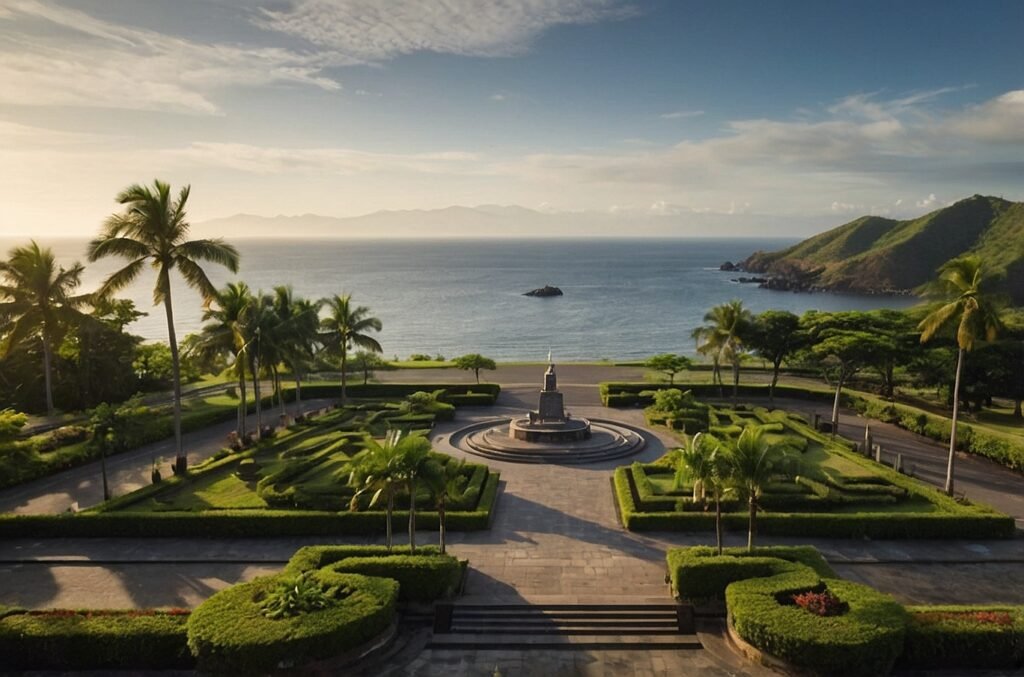Hey there, history buffs and beach lovers! Today, we’re diving into the fascinating world of Bataan, a peninsula in the Philippines that’s not only steeped in history but also boasts some seriously stunning beaches. Whether you’re a history enthusiast, a nature lover, or just someone looking for an off-the-beaten-path adventure, Bataan has something for everyone. So, grab a cup of coffee (or a refreshing coconut drink), and let’s explore this hidden gem together!
The Geography of Bataan: Where History Meets Natural Beauty
Bataan isn’t just any ordinary peninsula – it’s a place where the land itself seems to tell a story. Located in the Central Luzon region of the Philippines, Bataan is bordered by the provinces of Zambales and Pampanga to the north, while the rest of its territory is surrounded by water. To the east, you’ll find Manila Bay, to the south is the entrance to Manila Bay, and to the west lies the South China Sea.
But what makes Bataan truly special is its diverse landscape. Picture this: lush mountains covered in thick forests, rolling hills that seem to stretch on forever, and pristine beaches with golden sand and crystal-clear waters. It’s like Mother Nature decided to show off all her best features in one place!
The peninsula is about 80 kilometers long and 30 kilometers wide at its broadest point. That might not sound huge, but trust me, there’s a lot packed into this relatively small area. From the towering peak of Mount Natib (which, by the way, is a dormant volcano) to the mangrove forests along the coast, Bataan is a nature lover’s paradise.
Fun fact: The name “Bataan” is believed to have originated from the Tagalog words “batang bayan,” which means “young nation.” Pretty fitting for a place that’s played such a crucial role in shaping the Philippines as we know it today!
A Walk Through Time: Bataan’s Rich History
Alright, history buffs, this is where things get really interesting. Bataan isn’t just a pretty face – it’s been at the center of some of the most pivotal moments in Philippine history. Let’s take a little journey through time, shall we?
Pre-colonial era:
Long before the Spanish arrived, Bataan was home to various indigenous groups. The Ayta people, in particular, have a rich cultural heritage that’s still evident in parts of Bataan today. These early inhabitants lived off the land, fishing in the bountiful waters and cultivating crops in the fertile soil.
Spanish colonial period:
When the Spanish colonizers arrived in the 16th century, Bataan became an important strategic location. The Spanish built fortifications and churches, many of which still stand today as a testament to this era. The province played a crucial role in the Philippine Revolution against Spanish rule in the late 19th century.
American colonial period:
After the Spanish-American War, the Philippines came under American control. Bataan continued to be an important military and economic center during this time.
World War II:
Now, this is where Bataan’s history takes a dramatic turn. During World War II, Bataan became the site of one of the most infamous events of the war in the Pacific – the Bataan Death March. We’ll dive deeper into this later, but suffice it to say, this event left an indelible mark on the province and its people.
Post-war era to present:
After World War II, Bataan focused on rebuilding and development. Today, it’s a thriving province that honors its past while looking to the future. The peninsula has become a hub for industry, tourism, and conservation efforts.
The Bataan Death March: A Somber Chapter in History
Now, let’s talk about the event that put Bataan on the world map, albeit in a tragic way – the Bataan Death March. This is a heavy topic, but it’s an essential part of understanding Bataan’s significance.
In April 1942, after months of fierce fighting against Japanese forces, American and Filipino troops in Bataan were forced to surrender. What followed was one of the most brutal episodes of World War II. Approximately 75,000 Filipino and American soldiers were forced to march 65 miles from Mariveles, Bataan, to San Fernando, Pampanga. From there, they were transported via rail to Camp O’Donnell in Tarlac.
The conditions during this march were horrific. Prisoners were denied food and water, subjected to physical abuse, and many were executed along the way. Thousands died before reaching their destination. It’s a sobering reminder of the human cost of war.
The impact of the Bataan Death March:
- Estimated 5,000-18,000 Filipino deaths
- Estimated 500-650 American deaths
- Lasting impact on survivors and their families
- Became a symbol of wartime atrocities and resilience
Today, the Bataan Death March is commemorated through various memorials and events. The most notable is the Bataan Memorial Death March, an annual event held in New Mexico, USA, where participants honor the sacrifices of the soldiers by walking or running through the desert.
War Memorials: Honoring the Past, Educating the Future
Bataan takes its role as a keeper of history very seriously. Throughout the peninsula, you’ll find numerous memorials and museums dedicated to preserving the memory of those who fought and suffered during World War II. Let’s explore some of the most significant sites:
Mount Samat National Shrine:
Perched atop Mount Samat in Pilar, Bataan, this imposing memorial is impossible to miss. The centerpiece is a massive cross that stands 92 meters tall. You can actually take an elevator to the arms of the cross for a breathtaking view of the surrounding area. Inside the shrine, you’ll find murals depicting scenes from Philippine history and World War II.
Bataan World War II Museum:
Located in Balanga City, this museum houses an extensive collection of World War II artifacts, photographs, and documents. It’s a great place to dive deep into the history of the Bataan campaign and the subsequent occupation.
Filipino-Japanese Friendship Tower:
This tower in Bagac symbolizes the reconciliation between the Philippines and Japan after the war. It’s a powerful reminder that even after great conflict, peace and friendship are possible.
Zero Kilometer Death March Marker:
This marker in Mariveles marks the starting point of the Bataan Death March. It’s a solemn place that really drives home the reality of what happened here.
Visiting these memorials isn’t just about remembering the past – it’s about learning from it and ensuring that such atrocities never happen again. They serve as powerful educational tools, especially for younger generations who might not be as familiar with this chapter of history.
Beyond the Memorials: Bataan’s Natural Wonders
Now, let’s lighten the mood a bit and talk about something that might surprise you – Bataan’s incredible natural beauty. This peninsula isn’t all about history; it’s also a haven for nature lovers and adventure seekers.
Beaches that will take your breath away:
Bataan boasts some seriously stunning coastlines. Here are a few beaches you won’t want to miss:
- Anvaya Cove: This private beach resort offers pristine white sand and crystal-clear waters. It’s perfect for a luxurious getaway.
- Sisiman Beach: Known for its unique rock formations and pebble shore, this beach offers a different kind of beach experience.
- Five Fingers: This group of coves in Mariveles is a hidden gem. Each “finger” offers a unique beach experience, from sandy shores to rocky cliffs.
Mountain adventures:
If you’re more of a mountain person, Bataan has got you covered:
- Mount Natib: This dormant volcano offers challenging hiking trails and stunning views.
- Mount Samat: Besides the war memorial, the mountain itself is great for hiking and offers panoramic views of the peninsula.
Eco-tourism hotspots:
Bataan is also making a name for itself in the eco-tourism scene:
- Bataan National Park: Home to diverse flora and fauna, including some endangered species.
- Pawikan Conservation Center: Learn about and help protect sea turtles at this center in Morong.
The Flavors of Bataan: A Culinary Journey
No trip is complete without sampling the local cuisine, right? Bataan’s food scene is a delightful mix of traditional Filipino dishes and unique local specialties. Here’s a taste of what you can expect:
Must-try local dishes:
- Adobong Pusit: A squid dish cooked in soy sauce, vinegar, and garlic.
- Tinapa (Smoked Fish): Bataan is famous for its high-quality smoked fish.
- Pancit Palabok: A noodle dish topped with shrimp sauce, eggs, and various toppings.
- Araro Cookies: These cookies made from arrowroot flour are a local favorite.
Where to eat:
- Local markets for authentic street food experiences
- Seaside restaurants for fresh seafood
- Family-run eateries for home-cooked Filipino meals
Fun fact: Many of Bataan’s dishes have been influenced by its history, incorporating elements from Spanish, American, and even Japanese cuisine.
Practical Tips for Visiting Bataan
Alright, I’ve probably got you all excited about visiting Bataan by now. But before you pack your bags, here are some practical tips to help you make the most of your trip:
Best time to visit:
- Dry season (November to April) for beach activities and outdoor exploration
- Rainy season (May to October) for lush green landscapes, but be prepared for occasional showers
How to get there:
- By bus: Regular buses from Manila to Balanga City (about 3 hours)
- By car: Drive from Manila via NLEX and SCTEX (about 2-3 hours depending on traffic)
Where to stay:
- Balanga City for urban conveniences and easy access to historical sites
- Coastal towns like Morong or Bagac for beach resorts
- Eco-lodges in the mountains for nature enthusiasts
Local etiquette:
- Respect historical sites and memorials
- Dress modestly, especially when visiting religious sites
- Learn a few basic Tagalog phrases – locals appreciate the effort!
The Future of Bataan: Balancing Progress and Preservation
As we wrap up our journey through Bataan, it’s worth taking a moment to consider the peninsula’s future. Like many places with rich historical and natural heritage, Bataan faces the challenge of balancing development with preservation.
On one hand, there’s a push for economic growth. Bataan is home to the Freeport Area of Bataan, which is attracting investors and creating job opportunities. The tourism industry is also growing, bringing in much-needed revenue.
On the other hand, there’s a strong commitment to preserving Bataan’s historical sites and natural wonders. Conservation efforts are underway to protect endangered species and maintain the peninsula’s biodiversity.
It’s a delicate balance, but one that Bataan seems committed to maintaining. By visiting responsibly and supporting local initiatives, we can all play a part in ensuring that Bataan’s unique blend of history and natural beauty is preserved for future generations.
Why Bataan Should Be on Your Travel Bucket List
So, there you have it – a whirlwind tour of Bataan, from its somber war memorials to its sun-soaked beaches. It’s a place that offers a truly unique travel experience, one that combines historical significance with natural beauty in a way few other destinations can match.
Whether you’re tracing the steps of history at the Death March markers, soaking up the sun on a pristine beach, hiking through lush forests, or savoring local delicacies, Bataan has something to offer every type of traveler.
But more than that, visiting Bataan is an opportunity to connect with a pivotal moment in world history, to pay respects to those who sacrificed so much, and to witness firsthand how a place can honor its past while looking to the future.
So, why not add Bataan to your travel bucket list? It’s a journey that promises not just beautiful sights and exciting experiences, but also a deeper understanding of history and the resilience of the human spirit. Trust me, it’s an adventure you won’t forget!
Disclaimer: While every effort has been made to ensure the accuracy of the information presented in this blog post, historical events and details may be subject to different interpretations. Travel information and local conditions may change over time. We encourage readers to conduct their own research and consult local authorities for the most up-to-date information when planning a trip. If you notice any inaccuracies in this post, please let us know so we can correct them promptly.




